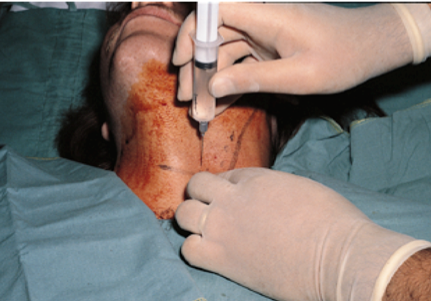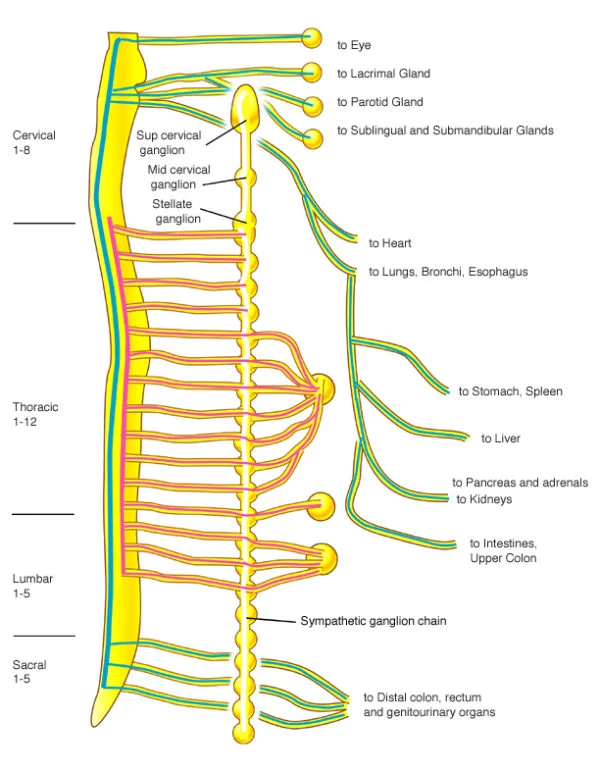Stellate Ganglion Block
Overview
Your body has special nerves known as sympathetic nerves in your neck which control blood supply and sweating to your arms and hands. These nerves can be anesthetized to change the blood flow to a limb and to decrease the pain which is mediated by these sympathetic nerves:
Reflex sympathetic dystrophy (RSD), also called Complex Regional Pain Syndrome (CRPS) typically involves a nerve injury involving the sympathetic nervous system. Patients who suffer crushing or partial nerve injury develop excruciating burning pain accompanied by changes in blood supply to the area of the injury. People with CRPS may exhibit abnormal sensation throughout all or part of the affected area. This often includes increased sensitivity to stimuli such as touch, pressure, or temperature.
Patients with severe ischemic limb pain have sharp, aching pain as a result of circulatory insufficiency. Patients in end-stage PVD (peripheral vascular disease) will complain of rest pain with or without ulcers.
- Severe pain (claudication and rest pain)
- Decreased pulse in the limb
- Abnormal skin temperature
- Abnormal skin color
- Nonhealing ulcers
- Other trophic changes


Common types of PVD
- Arteriosclerosis
- Diabetic arteriosclerosis
- Raynaud’s disease
- Buerger’s disease
What Is The Purpose Of Stellate Ganglion Block?
The Stellate Ganglion Block is an injection procedure used to block or decrease pain located in the head, neck, chest, or arm. It also helps increase circulation. The Stellate Ganglion is a group of nerves located in the upper neck and is part of the sympathetic nervous system. After an injury or illness, the sympathetic nervous system may not function properly, causing pain. Some of the more common conditions are: complex regional pain syndrome (CRPS) also known as reflex sympathetic dystrophy (RSD), causalgia (nerve injury), and herpes zoster (shingles) of the head and face. The Stellate ganglion block is also used to treat intractable angina (severe pain caused by heart disease) or severe peripheral vascular disease (PVD).
If this treatment relieves your pain, the doctor will perform a series of blocks at another time in an attempt to break the pain cycle and provide long lasting pain relief. The number of blocks you will need depends on how long the pain relief lasted between injections. Usually you will get more and longer pain relief after each injection. Some patient’s get short-term relief with Stellate blockade, but the series of blocks fails to provide long-term relief. These individuals are usually considered candidates for Dorsal Column Stimulation (DCS).
What Does The Procedure Involve?
The nerves going to the arm can be anesthetized in one of two place; the low neck which is known as a stellate block, or the upper chest area known as a T2 sympathetic block. The Stellate Ganglion Block is an outpatient procedure, usually done in the Operating Room or a Procedure Room. For your safety and comfort, you will be connected to monitoring equipment (EKG monitor, blood pressure cuff, and a blood-oxygen monitoring device). The doctor or nurse may start an intravenous line and give some medicine to help you relax. You will also have skin temperature monitors placed on your hands. The procedure is performed with you lying on your back.
A rolled-up sheet or other support is placed between your shoulder blades, which may be a little uncomfortable. After cleansing your neck with an antiseptic solution, the doctor will inject numbing medicine into the skin and tissue. This may cause a burning sensation for a few seconds. The doctor will also apply some pressure on your neck to determine exactly where to place the needle. It is very important that you do not talk, swallow, or cough. If you have to swallow or cough, raise your hand to let someone know.
After the numbing medicine takes effect the doctor will insert another needle, and with the assistance of a special X-ray machine called a fluoroscope, inject a radiopaque dye (contrast solution) to confirm correct needle position. When satisfied with the needle position, the doctor will inject a small mixture of numbing medicine (anesthetic) and anti-inflammatory medicine (cortisone/steroid).
Although it takes about 10 to 20 minutes for the medication to take effect, you will remain at the Clinic until the doctor feels you are ready to leave. If the block works, then your hand will warm up and (depending upon the source of your pain) your pain may improve. When utilized for CRPS (RSD), stellate blocks are used as a way of getting you to work with physical or occupational therapy to desensitize your arm or hand.

Discover Relief With Stellate Ganglion Block
What Should I Do Before The Procedure?
Since you will be receiving medication, it is recommended that you do not eat within four or five hours before the procedure. If you are a diabetic, be sure to discuss your eating and medication schedule with the doctor. You may need to stop taking certain medications several days before the procedure. Please remind the doctor of all prescription and over-the-counter medications you take, including herbal and vitamin supplements. The doctor will tell you if and when you need to discontinue the medications.
It is very important to tell the doctor if you have asthma, had an allergic reaction (i.e. hives, itchiness, difficulty breathing, any treatment which required hospitalization) to the injected dye for a previous radiology exam (CT scan, angiogram, etc) or if you have had an allergic reaction to shellfish (shrimp, scallops, lobster, crab). The doctor may prescribe some medications for you to take before having the procedure.
Tell the doctor if you develop a cold, fever, or flu symptoms before your scheduled appointment. You need to be aware of several potential side effects.
These side effects, which usually disappear four to eight hours after the block may include:
- A droopy eyelid on the side of the block; Redness and blurred vision in the eye on the side of the block; A feeling like a lump in your throat; Difficulty swallowing; Hoarseness of your voice; Warmth and weakness of the arm on the side of the block.
- Drink plenty of clear liquids after the procedure to help remove the dye from the kidneys and do not eat solid food until you are comfortable swallowing.
- Do not drive for the remainder of the day. Please have an adult drive you home or accompany you in a taxi or other public transportation.
- Depending on how you feel, you may resume normal activities and return to work the following day.
- If the doctor prescribes physical therapy, it is very important that you continue with the physical therapy program.
- Although you may feel much better immediately after the injection (due to the numbing medicine), there is a possibility your pain may return within a few hours. It may take a few days for the steroid medication to start working.
- You must participate in physical therapy, in order to get long-term control of symptoms. Desensitization physical therapy can be an effective way to treat hypersensitivity, especially when used in combination with other medical and/or therapeutic interventions. The stellate blockade is both diagnostic (helps diagnose the cause of your pain) and therapeutic (treats the cause of your pain). You may need a series of injections in order to achieve long-term pain control. Please keep track of your symptoms after the block.
What Are The Risks Of A Stellate Ganglion Block?
- Collapsed lung
- Numbness of an arm that may last for hours
- Temporary weakness or numbness from the neck down
- Allergic reaction to the medication
- Nerve damage
- Bruising at the injection site
- Infection at the injection site
- Injection of medication into a blood vessel with possibility of stroke or seizure
- Post-injection flare (nerve root irritation with pain several hours after treatment, which may last days or weeks)
- Depigmentation (a whitening of the skin)
- Local fat atrophy (thinning of the skin)
- Destruction of a motor or sensory nerve in the path of the needle
- Bleeding, nerve injury, organ injury and death are rare but possible
Note: If you experience new shortness of breath 24 – 48 hours after the injection or any signs of infection in the area of the injection you should go to your nearest emergency room immediately.
